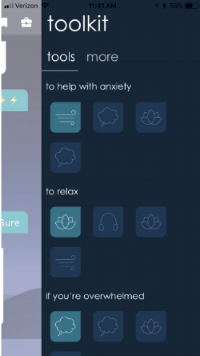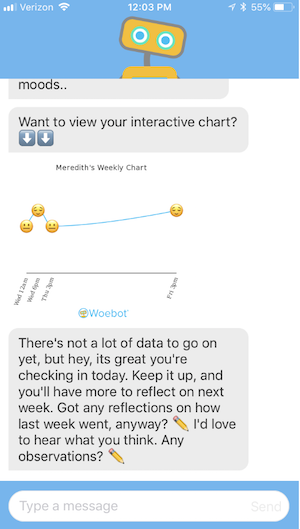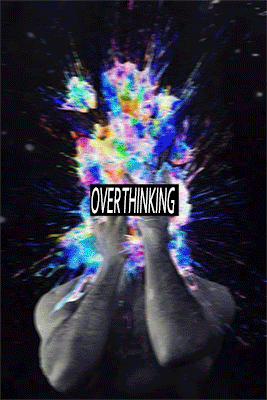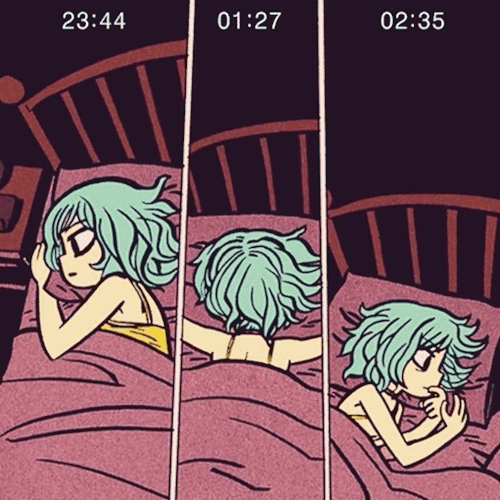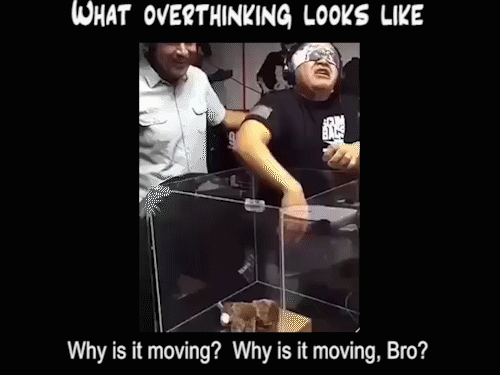
Explore how anxiety can show up in your life, work, and relationships
Read on
Why “I Beat Anxiety” is a Terrible Title
Nearly every day I receive a new trending anxiety article via text or Facebook messenger from a smart, well-read friend or family member. The piece usually looks like this...
This is not the right approach for anxiety.
Ditto for “Overcame,” “Conquered,” and “Escaped.”
Because I’ve been working on Beautiful Voyager for the past three years, nearly every day I receive a new trending anxiety article via text or Facebook messenger from a smart, well-read friend or family member. The piece usually looks like this:
Wall Street Journal, April 28, 2017
These headlines always make me groan. I know they are perceived as what will garner clicks, but they just cause more problems for readers. Whether the writers or editors chose the titles, this is often how anxiety articles are packaged.
The problem is: what gets clicks wends its way into hearts and minds. This framing will not help people who actually have anxiety. In fact, it will exacerbate the problem.
Those of us who have anxiety are always looking for answers. We google until our fingers are numb. We read every book we can find. We covertly study. We slyly interview. We believe that if we work hard enough, we will find a way to beat, escape, or conquer anxiety.
Look ma, more muscles!
Alas, all of this trying and searching is only adding to our anxiety. It is part of the problem, not the solution.
There is no path “out of” anxiety. If you have an anxiety disorder, like Andrea and I do, then like us, anxiety will likely be some part of your entire life.
Does this mean that you can’t be happy? No! You can find many ways to feel safe and comfortable with who you are, anxiety and all. But the false promise these headlines are selling in order to get your click — that you can no longer feel the pressure of anxiety if you just read what someone else did to work on theirs — is a lie. And it needs to stop.
Et tu, Psychology Today?
We all need to stand up to click-bait anxiety titles, but this critique is really aimed at my fellow writers.Ask yourself, “Do I really mean what I’m saying when I write ‘beat anxiety’? Or am I just wanting a dopamine hit from getting a bunch of clicks?”
If it’s the latter, then perhaps you, too, need to ride the wave and adjust your expectations.
Tandem surfing was actually a thing in the 60s.
What I want people with anxiety to know: you’re not alone in feeling confused. You don’t need to Arnold the situation to be OK. There are many tactics to try, but since no two anxieties are the same, what worked for others won’t always work for you. Keep experimenting and you will find calmer, happier shores.
And good luck on that wave!
Originally published in April 2017. Updated in September 2018.
Try A CBD-Enhanced Bath
What does a CBD bath feel like, exactly? The answer depends on your symptoms. Read these two reviews of Antidote Herbals CBD bath bombs and find out what the experience is really like.
As you can see, the packaging described that it has 60 MG of CBD in it, in addition to magnesium, menthol, and mint. More info about ingredients here.
Last week, Rebecca Jennings of Vox published a story called Fidget Spinners, Weighted Blankets, and the Rise of Anxiety Consumerism. In it, she talks about the Beautiful Voyager origin story. Since the piece came out, there has been a surge in people visiting Beautiful Voyager, but there has also been a surge in the people sending me products to test. Earlier this morning, I tested one of those products, the Migraine/Anxiety CBD Bath Bomb from Antidote + , $29 for 3.
I shared my experience in real time on Instagram, but figured it would be helpful to lay it out here, too, in story form, including my review. Here’s the step-by-step experience. Results below!
Here’s an insight into setup. The bath bombs come with detailed instructions about when to take the bath, and how.
Why I chose to do the review today.
Make your bath hot, not warm, and know that cannabinoids, menthol, and magnesium are the magical combo.
It’s useful to know that you will be taking a leprechaun bath.
Sorry this is vertical. It’s hard to figure out how to make videos work in all settings.
The instructions say you need to hang out in the bath for at least 20 minutes (though the Antidote website suggests soaking for 30 minutes, so maybe the longer the better?).
That was not a problem for me.
The full list of ingredients to the bath bomb: bicarbonate of soda. citric acid. maize starch. epsom salts. organic coconut oil. organic peppermint essential oil. cannabinoid oil blend. food-grade color pigments.
Review #1: CBD Bath Bomb From Non-Anxious Person (Meredith’s Husband)
At first, I didn’t think it felt very different than a regular bath, though I feel everyone should take my feedback with a grain of salt since I usually question whether CBD does anything for me. I really liked the smell. Over time, though, I noticed that I was more relaxed than usual. How much would I spend for a relaxing good-smelling bath like this? Probably $3-5.
Final thought: At first, I didn’t think I was feeling much, but 15-20 minutes later, I noticed I was feeling very relaxed. If someone gave me this as a gift, I would definitely be happy about it.
Review #2: CBD Bath Bomb From Migraine Sufferer (Meredith)
I took my CBD bath the morning after a migraine, at a moment when I had a lot of neck tension. As I got into the bath, I immediately noticed the menthol smell was soothing and good for my sensitive nose. I also tuned into the feeling of the coconut oil on my skin. It wasn’t just softening, it encouraged muscle release and neck massage. In terms of the CBD, it definitely adds a new tingly sensation to the bath that is helping my body chill out. I always appreciate this kind of feeling. Since I have very physical symptoms to my anxiety, starting with body relaxation is key for me.
It’s been about an hour since I took the bath. I still feel relaxed and calm and ready to tackle my day in a grounded way. I think the key question is: Is this feeling worth a $10 bath bomb? My answer: It depends on how much you are suffering. If more than one person in your house can use the bath at a given time, that helps bring down the price.
Final thought: I initially thought I wouldn’t buy these CBD bath bombs for myself because I’m bad at that kind of indulgence, but just two weeks later, I found myself reordering these bath bombs and giving them away as gifts. If you’re looking for a great present idea for someone like me, this is the way to go.
What about you? Have you tried a CBD bath bomb? How did it work for you? Let me know!
The Best Career Advice I Ever Got
Four years ago, I was moving from startup to startup, confused about my future but leaning into the roles I thought others valued. In the middle of the confusion, I had lunch with a wise friend.
It’s 5 AM. I woke up earlier than usual this morning, roused by the sound of my dog throwing up. Not the greatest way to meet the day, but luckily, I love her.
Love makes vomit easier to handle.
Speaking of vomit...
Four years ago, I was moving from startup to startup, confused about my future but leaning into the roles I thought others valued. In the middle of the confusion, I had lunch with a wise friend. An artist and actor, she knows how to read people, and she knew me well. I remember we were eating brunch in San Francisco, near the water, a view of the Bay Bridge before us. I was telling her about my latest job:
“I think it will be good. I am in charge of figuring out how to break engineering work into manageable cycles while working with the operations team to make sure our products are aligned with their expectations.”
My friend got a confused look on her face. Her response was immediate and to the point. In a direct and loving way, she said, “Meredith, don’t you think you might need to be a little more creative in your role? I remember how happy you were working on videos in your past job. You loved that.”
I trust Molly. When it comes to creativity, she knows what she's talking about.
It’s incredible how much a single question can affect the course of your life. I thought long and hard about what she said. Over the next couple of years, I slowly righted the ship. I started by building Beautiful Voyager, an experience that reminded me of my core strengths. These days, I’m happy and secure in a creative role at a larger company I love.
There you have it. The advice that wasn’t advice, but a question. I asked the Beautiful Voyager community to share the best advice they’ve ever received. Here’s what one person said:
The best career advice I was ever given was actually through an NPR interview with the founder of Spanx, Sara Blakely. She advised “whenever you can afford to do so, delegate the things you aren't good at.”
Though this seems like basic business acumen, it was an eye-opener for me. As a business owner who is also a perfectionistic overachiever and control seeker, the idea of delegating is scary. Once I accepted myself and chose to trust others, the process of feeling safe through delegation began. Of course, finding people who share the passion for our business and services was essential, and now that we have them, my anxiety (and overthinking!) has been relatively put to rest.
I love that it came from the Spanx founder! Trusting others is incredible advice. Thank you for sharing. Here’s another:
The best advice that I ever got was personal rather than professional and it also came in the form of a question. It was about 10 years ago and I was having lunch with some friends. After mentioning that I was once again returning to counseling because of my depression and issues related to my marriage, one of my friends asked, “If you had to do it over, would you marry your husband?” When I said that I wouldn’t, he asked, “Then why are you still with him?”
It’s wonderful how direct questions asked by a dear friend can give a girl the kick in the pants that she needs. Because of that question (and the unwavering support of that handful of friends), I found the strength to leave an emotionally-abusive marriage after 17 years, move to another state, and start over.
Do you have your own story to share? Write it in the comments and share your insights with others! It just feels good to help.
Video Interview with Little Panic Author Amanda Stern
Yesterday afternoon I had the pleasure of meeting and talking to Amanda Stern, author of Little Panic: Dispatches from an Anxious Life on in a Beautiful Voyager Facebook live chat. It was such a joy to get to find out from Amanda herself, whose book I loved, about how the book came to be, and what it feels like to talk about her panic disorder publically.
Two Gen Xers Share a Facebook Live Chat and Live to Tell The Tale
Yesterday afternoon I had the pleasure of meeting and talking to Amanda Stern, author of Little Panic: Dispatches from an Anxious Life on in a Beautiful Voyager Facebook live chat. It was such a joy to get to find out from Amanda herself, whose book I loved, about how the book came to be, and what it feels like to talk about her panic disorder publically. It's a long interview (1 hour!) so I wanted to break down different areas so that you can forward to the area that interests you.
2:20 The interview really begins (the first two minutes are warm up).
4:45 How it feels to be talking about panic disorder in real life.
6:30 Anthony Bourdain and Kate Spade's suicides affected this public moment.
8:38 Jenny Slate would play Amanda Stern if there were a movie version of this book.
11:38 How writing is almost like doing EMDR on yourself.
13:49 How the fear of not being educated enough may have held her back.
19:15 Panic disorder wasn't in the vocabulary, therefore people didn't spot it.
14:40 The difference between gut (trust the gut) and the feeling of doom (don't trust it).
28:04 The last panicked experience Amanda had. What happened, and what it felt like.
36:45 Amanda and I both talk about how amazing the book The Worry Cure is.
38:45 My very personal take on why Scott Stossel's book is the result of a stigmatized culture.
45:53 Amanda's next voyage may be: intelligence testing.
50:19 Amanda's advice for parents who may be dealing with anxiety disorders in their children.
54:30 What Amanda and I are worried about right now.
57:13 Amanda is going to be in San Francisco and we are going to meet up. Come see her read from her book and say hello to me too!
A Beginner's Guide to Generalized Anxiety Disorder
This short guide is meant to help people who, like me at the time, are just beginning their journey with GAD. If you find yourself googling like crazy and not being able to find answers to your questions: Welcome, kindred soul.
At first, it can be hard to even recognize what forward movement even looks like.
When I was first diagnosed with Generalized Anxiety Disorder, I went searching high and low for a guide that would help me understand what I needed to know about what that meant and what I should do. It was a very confusing time. I googled like crazy, but found nearly nothing online that informed me in a real, useful way. This was way back in 2015, and at the time there was much less than there even is now. Many "guides" used the word worry repeatedly. Worry wasn’t what I did or how I identified. Overthinking, yes. Worry, no.
Then I read a quote from the tennis player Mardy Fish that captured my experience of anxiety in vivid detail. He says: “I wish I had been able to tell myself that I was doing great. But my frame of mind back then couldn't process great. All I could focus on was doing better.”
This short guide is meant to help people who, like me at the time, are just beginning their journey with GAD. If you find yourself googling like crazy and not being able to find answers to your questions: Welcome, kindred soul.
Q. What is Generalized Anxiety Disorder, exactly?
A. If you've already been researching this, you know that GAD is often described as a psychological disorder characterized by excess “worry” particularly about work, finances, and relationships. That's now how it felt to me. I've noticed that often people with GAD don't realize they have it for a long time in part because they don't think of themselves as worriers.
You might hear that GAD means you worry about worry. If you don’t even consider what you're experiencing as worry, that bit of information doesn’t help. And if you are so habituated to pushing away the worry as a coping mechanism, then descriptions like that will lead to a vicious avoidance cycle.
For me, having GAD means that I tended to overthink nearly everything, meticulously trying to figure it all out. When problem arose, I’d write them down and begin my crazed attack in every direction. More noticeably, it also meant crippling shoulder and neck pain and nausea, especially on buses. I used to get dizzy at times, almost to the point of fainting. The physical symptoms are important: this is what can help you get diagnosed faster. Don't ignore them!
Q. Can a person have GAD and not know it?
A. It's more common than not that people who have GAD see many doctors before they get properly diagnosed. Gastroenterologists, chiropractors, neurologists, acupuncturists, and gynecologists are some of the people Gaddies might visit on the path to diagnosis.
Q. Is GAD hereditary?
A. Yes, there is a genetic component, but as is often the case, that’s only one part of the equation. Genetic roots and predisposition to anxiety disorders can be triggered by environmental factors. The death of a loved one, divorce, the sudden loss of a job or your house, or a big change in circumstance can bring on episodic fare-up of GAD.
Q: If GAD flares up, does that mean it’s dormant at other times?
A: Even if you're predisposed to GAD, with proper treatment, you can bring your symptoms into check. Since you are predisposed to this condition, when things happen to you, you will be more likely to have bigger anxiety responses than other people.
Q. How messed up is someone with GAD, exactly? Please be specific.
A. It depends on the person. My GAD makes me aware and worried about silly stuff like taking out the garbage. My family teases me about my absurd fear that if I miss taking out the garbage, our house will be overtaken with garbage. It makes me laugh, but the laughing doesn't stop my anxiety symptoms from coming around every Sunday.
Or this example from years ago, when a few ants were coming through our bathroom window. My response was immediate: "Let's replace the window." It didn't matter that we couldn't afford it. I just wanted the stress to go away. And why was there stress? It was because I didn't see the few ants on the floor. I saw an inevitable 100–200 ants that I imagined would invade and carry off our house.
It’s very hard to be in the here and now when catastrophizing. (Catastrophizing is a cognitive distortion. Learning to recognize cognitive distortions is one important element of cognitive behavioral therapy, the best method for treating GAD.)
A neighbor put it well when he said: “I realized that I did everything in a rush—even simple things like brushing my teeth or making coffee. Eighty percent of what I do on a typical day does not require hurrying and rushing. That rushing creates a lot of stress throughout the day.” I know exactly what he means. I sometimes have the feeling that if I don’t get a certain small household task done at any given moment, the world might end.
Gaddies are not known for their patience.
Q. If I have GAD, how do I make it go away? Does it last forever?
A. Learning to ride the wave is a great place to start. When stressful things happen, you can expect to feel your own particular gremlin poke his head out of the wave’s crest. Knowing what to do with him and that I’ve survived his visits before helps a lot. Here's some more information about whether generalized anxiety goes away.
My own personal trifecta of how to settle the wave is: Meditation. Medication. Communication. Of course, each person has different needs and a different approach. The way to figure out what works is to experiment.
Q. Can anyone develop GAD? What’s the line between having it and just being a regular stressed out American?
A. The difference between regular anxiety, stress, and GAD comes down to degree. Most people with everyday stress and anxiety aren’t fainting or getting up in the middle of the night. They don’t need neck rubs every day. And they aren’t negatively predicting the outcomes of regular social interactions in a way that adds extra stress to daily life.
A fellow Beautiful Voyager described it this way: “I tend to project into the future all the time. I’m often planning how to deal with some negative turn of events that might happen in the future. Most likely never will. So I’m worrying in the present about something that will never happen in the future.”
If his experience sounds familiar, you might want to keep reading about Generalized Anxiety Disorder.
Q. Is GAD what has been wrong with me?
A. If what you're reading here rings that inner bell of familiarity, you might want to pick up the book The Worry Cure. Don’t think about the title too much. Just investigate your physical symptoms through the lens of your thoughts paying attention to whether what this book has to say relates to you. If it doesn't, then it's likely not GAD that's been bothering you.
Q. Will I ever feel better if I have GAD?
A. I believe that you can feel better if you have GAD. Simply the fact that you're reading this now means that you're on the path.
Q. How do you know?
A. Times are changing. People are talking openly about depression, anxiety, and other forms of mental suffering in a way that they never did when I was younger. The more people speak openly about the spectrum of mental conditions, the more they can be helped earlier on.
Q: What should I do if I’m a friend or family member of a Gaddie?
A: I feel for you. It’s not easy to deal with an anxious person, especially at the high pitch levels that people with GAD specialize in. It’s hard to avoid the role of friend-therapist. You might find yourself talking your friend down and trying to give them a more realistic view of their surroundings. The goal is to help them build those muscles for themselves without exhausting yourself. Bottom line: put the oxygen mask on yourself first.
On the other hand, GAD often presents as perfectionism or invulnerability, so it can be confusing. How do you help someone who doesn’t seem to need help? By tuning in to your instincts. Is the person talking super fast? Are they in a lot of physical pain? If so, they may need to help to learn a new way of thinking about the world around them/
You can gently encourage them to stay grounded in the moment. Send them a link to this piece. Do it with love.
New Mental Health Apps Reviewed: Wysa, Woebot, Joyable, and Talkspace
A few months ago, I was asked by Healthline to review a handful of mental health apps for a story the team was working on.See what I learned about mental health on the go, and see if this type of exploration might be right for you.
A few months ago, I was asked by Healthline to review a handful of mental health apps for a story the team was working on. Well, that story is now live on the site. I thought that it might be interesting to share my original reviews for Wysa, Woebot, Joyable, and Talkspace, popular mental health apps on the market now. In addition to paying subscription fees, I was paid $150 to write these reviews (I like transparency around Beautiful Voyager money matters). So take a look at these 4 mental health app reviews and see if you agree with what I found.
Wysa
Cost: Free with In-App Purchases
At first, the differences between Wysa and Woebot were hard to spot. Both are chatbots with a cognitive behavioral focus. Both have daily check-ins. Both offer pre-filled answers to make the check-ins easier (which I appreciated).
I like that the app has small moments of interactivity threaded through the experience.
I also liked some of the interactions. To tell Wysa how you’re feeling every day, you slide the big yellow emoji face up and down. That felt fun and easy.
My interest in Wysa waned pretty quickly though. The app never seemed to know what time of day it was, and the constant presence of the little moon in the upper righthand corner of the screen became a small reminder of how rudimentary the bot really is.
I found Wysa’s requests for more information tiring. It kept pestering me to tell it more about how I was feeling without any examples of what it meant or why that would help me.
Gifs kept popping in at the wrong times and loaded slowly instead of automatically, the way gifs normally do, interrupting any momentum that I may have been building during the check-in. I found the app’s humor cloying. It wasn’t able to read my signs...or my terse responses, which were a sign of annoyance.
How would you rate the apps user friendliness? Consider a person who is having a bad day (would they be likely to stick with it or are there aspects of it that would be too frustrating?)
I’d find Wysa too frustrating to stick with on a bad day. I’m not a big fan of being asked what I’m feeling constantly, especially without guidance about the scope of response desired. Open-ended questions stress me out. I felt like Wysa didn’t understand the mind of an anxious person. It sometimes created more stress in me to figure out how to chat with it.
How does Wysa compare to in-person therapy? Better? Worse? How and why? Definitely worse. The missteps were clear signs that I was chatting with a very imperfect chatbot. It made me lose interest quickly.
If it needed to learn from me in order to improve, it didn’t make it clear what I needed to provide it to get to that improvement. It felt like I was throwing effort down into a well, and nothing new was coming out.
What the easy toolkit access looks like.
What are the best features of Wysa (3 max)? Why are these features so helpful? Where do you feel it could use improvement (2 max)? Why do you feel this needs improvement?
Best
Easy toolkit access to guided meditation and mindfulness activities helps offer a way to guide the chats in useful directions.
Ability to “activate coach” (for a price) and chat anonymously with a coach who will guide you to the right tools.
Pre-filled responses and fun little interactions to make chatting more fun.
Worst
Constant requests for more information without understanding why or how that helps me.
Humor was a little cloying.
Woebot
Cost: Free
Woebot’s a well-written chatbot. With pre-filled answers (see how the word “interesting” is right there for you to hit and keep going?) and guided journeys, it feels more like an interactive quiz or game than a chat.
Woebot’s daily check-ins start with a question about where you are and what you’re doing, but unlike Wysa, it doesn’t push with open-ended prods. Instead, it asks you to choose a quick emoji that describes what you’re feeling. That’s simple enough.
Over time, Woebot charts those emoji responses to help visualize trends, then shares that chart with you, allowing you to understand why you should bother checking in daily.
I often used Woebot on my morning commute, and I found it easy to use in any environment—an advantage of any chatbot. The loud sounds on the train didn’t affect my morning check-in, and I could whip it out between meetings to have something positive to focus on.
How does Woebot compare to in-person therapy? Better? Worse? How and why?
Let’s look at the factors that make therapy difficult for some people: time and price. Both of those issues are removed when it comes to Woebot. Does that make Woebot better? No, but it certainly makes it easier.
On the advice of others, I went to numerous therapists for varying periods of time over the course of my 20s and 30s. They were caring people, but they weren’t able to diagnose my true problem: Generalized Anxiety Disorder. (I was diagnosed by a neurologist in 2015.) It was the insight that anxiety was causing physical pain that helped me the most of all.
This is where the comparison between a chatbot like Woebot or Wysa and in-person therapy breaks down. If you’ve downloaded an app that describes itself as an: “emotionally intelligent chatbot who reacts to the emotions you express unlock tools to help with anxiety, stress, low mood, anger or sleep issues” (Wysa on the App Store) or a “choose-your-own-adventure mental health manual that gets more specific to your needs over time” (Woebot), you are likely already in the ballpark of knowing what is happening with you. Since that is more than half the battle, the bots can build on that understanding. In-person therapists, however, aren’t necessarily meeting people with that level of awareness, and as a result, they can cause accidental confusing digressions on the road to self awareness.
A trend chart can help me with a wider perspective on my moods.
In other words: self-knowledge is the most important part of mental health growth, regardless of the format of the treatment. People at different stages of the journey, or with different needs, might find a chatbot more helpful than in-person treatment. I, however, preferred Joyable and Talkspace to Wysa and Woebot.
How would you rate Woebot’s user friendliness? Consider a person who is having a bad day (would they be likely to stick with it or are there aspects of it that would be too frustrating?)
I found Woebot friendlier than Wysa. To kickstart a habit change, chatbots feel more approachable than interacting with human beings: There is more control in starting and stopping a conversation. Ultimately, that same advantage is their downfall since being in control at all times makes truly shifting your mindshift a little harder.
What are the best features of Woebot (3 max)? Why are these features so helpful? Where do you feel it could use improvement (2 max)? Why do you feel this needs improvement?
Best
It shares well-timed information and doesn’t drag.
Simple and clear. Woebot is easy to use. It would be easy to get into a morning routine of checking in, then seeing the trends could help me with a wider perspective on my moods.
Woebot provides background around why sharing information with it can improve the experience. The why is important.
Worst
It’s easy to lose interest when you’re using a chatbot. Just a few missteps in terms of responses, and you lose sight of why this is a good thing to be doing.
Hard to remember the correct prompts to take you to the toolbox, etc. I found that I lost track of where my charts, etc were stored, and I forgot which word I was supposed to used to get me back to that home base.
Joyable
Cost: $99/month with a 7-day free trial
Little example stories help illustrate the point at hand.
I’ve been a fan of cognitive behavioral therapy since I found out when I was first diagnosed with generalized anxiety in 2015. I loved the idea of an affordable approach to CBT and looked forward to giving this structured 2-month course a try (In fact, I ever created a poll for my Facebook followers back in 2016 to see if any of them had ever given it a try).
I liked the clarity of the approach: it’s intended to be just 8 weeks, so there’s no pressure to continue after it ends (The anxious people pleaser in me likes knowing how much time I’m signing up for, and how easy it is to cancel.) And each week, a new themed course is “unlocked,” allowing me the chance to tackle a new set of cognitive-behavior related challenges.
In Joyable, check-ins are over the phone, lasting anywhere from 15 to 30 minutes once a week with a coach (coaches are not therapists, as you’re reminded numerous times in the app). I was assigned a very nice young female coach who explained the entire process to me—again, this was appreciated—and led me through what was expected of me. Her name, phone number, and email address were all easily accessible from the coach tab. I was even able to look her up on LinkedIn and confirm that she was who she said she was, which helped me quickly get over any misgivings I had about talking with a stranger on the phone.
The basics of cognitive behavioral therapy, packaged in app form.
How does Joyable compare to in-person therapy? Better? Worse? How and why?
I think that in-person cognitive behavioral therapy can be incredibly helpful for someone with generalized anxiety disorder, but it can also be stressful to dedicate the time and money without having a clear sense of progression, a challenge I’ve had with therapy in the past.
In this way, Joyable’s 8-week program is a great compromise for people who want to work on daily challenges without the heavier commitment of in-person therapy. At the same time, a 15-minute phone check-in with a coach won’t likely see the same results that an hour with an experienced cognitive behavioral therapist might.
How would you rate Joyable’s user friendliness? Consider a person who is having a bad day (would they be likely to stick with it or are there aspects of it that would be too frustrating?)
This is an area where Joyable really shines. The program itself feels very easy to navigate, yet polished in a way that puts very little pressure on the person using it. The app isn’t needy, nor are the coaches you check in with. It is straightforward in a soothing way. To me, that is the ideal kind of friendliness.
Clear structure that helps orient you about where you are in the process.
What are the best features of Joyable (3 max)? Why are these features so helpful? Where do you feel it could use improvement (2 max)? Why do you feel this needs improvement?
Best
Very clear structure which helps you understand what is expected of you and how to progress.
Nice coaches who are also thoughtful people.
The courses themselves are well-illustrated, and the design of the app is nice and clean.
Worst
If you’re like me, and you already know the basics of CBT, the app probably won’t help you tackle problems in a new way. It is great for beginners, though.
If you don’t like talking on the phone, this app probably isn’t the one for you.
Talkspace
Cost: from $49 to $79 a week, depending on the plan
Talkspace has a longer sign-up process than the other apps I reviewed involving an initial intake process that lasts about a week and involves chatting with an “intake” therapist who asks basics questions about your past and needs.
Once your case has been handed over, you are presented with your therapist matches in the form of photos and bios. It’s up to you to choose a fit — it’s like a dating app, but for therapists.
I always love to see what types of people I’m paired with in a situation like this. In this case, I was given all women in their 40s in my initial pass. I asked for “more options” just to see what that looked like, and was given a wider array of ages, as well as one man. I chose the man, and received my first voice text within a couple of days.
I liked the asynchronous approach of Talkspace. It allowed me to leave messages at times that worked for me, then check my therapist’s responses at my convenience. There were some technical issues with the app that caused some confusions and delays, but they were short-lived. The biggest issue is that my therapist seemed to have a cold for weeks on end. For one reason or another, I didn’t really get to connect with him much in the two weeks I used the app.
Very clear onboarding is a big plus in my book.
How does Talkspace compare to in-person therapy? Better? Worse? How and why?
Talkspace has a lot of potential. Just like in-person therapy, much of its efficacy comes from the chemistry you have with the person you’re paired with. The asynchronous voice message / texting approach will work better for some people than others: I have enjoyed using other “voice memo” apps like Anchor in the past, so it worked well for me. I didn’t get a strong sense of the kind of impact the therapy might have on my anxiety since my therapist and I didn’t really get a chance to delve into that.
How would you rate the apps user friendliness? Consider a person who is having a bad day (would they be likely to stick with it or are there aspects of it that would be too frustrating?)
Talkspace doesn’t really have much scaffolding around it: It is just you talking to—or leaving messages for— a therapist. So the friendliness comes down to the person you’re paired with. My therapist had a friendly voice, and the control I had over how to engage with his messages felt friendly to me as well.
What are the best features of the app (3 max)? Why are these features so helpful? Where do you feel it could use improvement (2 max)? Why do you feel this needs improvement?
Best
Real licensed therapists.
The price isn’t bad!
I liked hearing human voices, but being able to listen when I wanted to.
Worst
As with in-person therapy, it can be hard to find the right therapist fit.
Pesky technical difficulties can get in the way of exchanging messages.
All in all, I really appreciated the opportunity (and motivation) to try out these mental health apps and deepen my understanding of the new trends in this space. What about you?
Have you ever tried a mental health app and if so what did you think? Share your thoughts below.
How to Avoid SAT Test Anxiety
According to these government statistics , 30 percent of Americans and 12 percent of Canadians and are affected by test anxiety, and research suggests that if left uncontrolled, it can decrease student performance by at least 10 percent. Here’s a helpful guide to working through test anxiety.
Standardized tests like the SAT have become a rite of passage for young adults going into college and graduate school, but they can also continue all through your working life.
The rigid, impersonal, pressured environment these tests create can exacerbate existing anxiety, and may even put the most stable individuals on a knife edge.
According to these government statistics, 30 percent of Americans and 12 percent of Canadians and are affected by test anxiety, and research suggests that if left uncontrolled it can decrease student performance by at least 10 percent.
Test Anxiety Is Not What You Think
To learn more, I spoke with psychology and behavior consultant Bill Cole, who gave this helpful example to explain what’s really going on with test anxiety:
“Let's say three of us are walking down the street. We turn the corner and we're confronted by two mean-looking, large dogs, baring their teeth and growling. And they're coming right toward us. I don't know about you, but I'd be up a tree or on a car roof in no time flat.
Maybe you'd be with me. But amazingly, we see our third friend simply standing still, and begin commanding the dogs to back off and to behave. And the dogs actually DO behave. Unknown to us, our brave friend is a dog trainer who knows exactly what to do in a situation such as this.”
Stress, in other words, is not an external phenomena, waiting to attack us—it comes from within. Stress isn’t the snarling dog, it’s our reaction to the snarling dog.
The amount of stress we feel, Bill says, is self-generated, and is not a simple cause-effect relationship. In this example, the dog trainer feels no stress because he had proper training. He had a plan worked out in advance, had lots of experiences around dogs, and he knew what to expect. To him, it was just another day at the office.
Tips for Avoiding Test Anxiety
The story about the dogs demonstrates how preparation and familiarity leads to confidence, which can then prevent a stress reaction from occurring.
Here are Bill’s recommendations for preparing to take a test:
1. Study hard and study correctly. Give yourself plenty of time—do not cram.
2. Make sure you know the test material well and can answer questions about it in the format the actual test will be in.
3. Set up practice testing conditions as close to the real conditions as you can.
4. Strive to score better than the practice test’s minimum passing grade. If you barely pass your practice exams, your chances of managing stress during the real exam will be quite low. The better you do in your practice tests, the less stress you'll feel in the real thing.
Real-Life Example
Heather, a postgraduate student who received counseling for anxiety, shared her experience taking standardized tests at Bristol University.
She spoke of feeling a “lack of control”, and “not-knowing if you are prepared enough.” Then, afterwards, she felt a daunting sense of finality, of not being able to make any more changes.
To deal with this, Heather said she ritualized the pre-exam process to create an internal environment that allowed her to thrive at crunch time. This included arriving at the test center 2 hours in advance, and then, instead of cramming last minute, chatting with classmates to lighten the mood.
Preparation was critical for Heather, and not just in terms of studying. She said that she maintained a good psychological state by watching something lighthearted the night before, eating a good meal, going to bed early, and eating a healthy breakfast the morning of the test.
Then, when she was finally at the desk, she felt a sense of calmness before the adrenaline kicked in and she started to write.
Of course, since anxiety affects people differently, others have reported having the opposite problem to Heather. Carolyn told Bevoya that the difficult part of standardized testing was not the fear of not knowing the answers, as that was something she could study. For her, anxiety typically stemmed from “anything more ambiguous or subjective”, like fearing there could be a section of the test she hadn't known about, or that she wouldn’t have enough time to finish
Takeaways
In addition to the tips that behavior consultant Bill Cole gave for avoiding test-taking anxiety, he also has some helpful ones for dealing with any situation that may cause you stress:
1. Pride yourself on handling higher and higher levels of stress. Call it grit, resilience or hardiness, but to deal with the higher pressures that bring higher rewards in life, you must learn to take stress in stride, and even to thrive on it.
2. Reframe stressful situations as challenging situations; learn that it's a choice how you view things.
3. Realize that while we often have little control over what happens in life, we have a lot of control over how we respond to what happens to us.
4. Create a strategy for how to respond to stress ahead of time, don’t merely react to it. Reacting is a knee-jerk, automatic, unthinking way of relating to events. Having a prepared response puts a pause between the stress trigger and your behavior, which allows you to take a deep breath, view the situation with care, and devise a strategy for dealing with it more effectively.
Handpicked Memes For You, Fellow Overthinker
For many people, memes capture the feelings and frustrations we feel inside that we just can’t quite express in words. The following memes have been created by or for all the overthinkers among us to capture all our many, many thoughts in .gif form.
Memes are evolving. These days, a well-placed gif doesn't just represent a cheap laugh or an easy Facebook like. For many people, memes capture the feelings and frustrations we feel inside that we just can’t quite express in words. The following memes have been created by or for all the overthinkers among us to capture all our many, many thoughts in .gif form.
1. The Overheated Brain
Have you ever felt the pain of the overheated brain? These gifs reveal what it can feel like to be an overthinker. When your brain gets overloaded with thoughts, it can be feel overwhelming. If you've struggled with overthinking for a long time, or have physical symptoms connected with your overheated brain, it might be a sign of General Anxiety Disorder. Learn more about GAD here.
2. The Outside Doesn't Match the Inside
You've probably seen this meme before. Who is this legendary little boy who feels he's drowning in one foot of water? The meme is recirculated regularly on social media who reappears periodically because it taps into a deep truth: overthinking makes us crazy about things that aren't actually scary.
I have an overthinking metaphor that I return to when I need to remember the power of perception. I visualize my brain's environment, knowing that I am the one person responsible for keeping that environment safe and calm.
3. Panic Before Planning
This gif embodies a common problem for overthinkers: We panic before we even taking the time to assess the severity of the problem. Feeling as though we're in trouble really isn't the same as being in trouble.
For a good strategy that will help you plan before panicking, take a look at this post about personal prioritization.
4. What Really is the Problem?
These math memes all allude to a shared overthinker's problem: Thinking too hard about a problem makes us lose focus of what we were trying to solve to begin with. Find some examples of this, as well as how to avoid the problem, here.
5. Sleep is Something You Can't Afford to Lose
Many of us can identify with the painful problem of not getting the deep sleep our brains need to heal themselves. Some of us lose sleep while mulling tiny details from our days over and over. We may be thinking about one problem, but the truth is that losing sleep is an even bigger problem for your brain. Learn more about what I mean here.
6. Brain Overload
A meme showing how bad it would look if the outside matched the feeling on the inside. Overthinking leads to stress which leads to health issues like chronic migraines. For some tips to help with those nasty headaches, look here.
7. Tomorrow's Stress Today
For the overthinker, the main business of the day is stressing about what might happen tomorrow. Whether it is work, relationships, or life in general, stress just seems to pile up for us overthinkers. You can find some helpful advice for coping with all of that stress here.
8. Stressing Over Social Media
Tweets, posts, snaps, texts, emojis, vines, likes, dislikes, retweets, unfriends, memes! It is much too easy for an overthinker to get #StressedOut by social media. Take a minute to realize you aren't alone and enjoy an infographic.
9. Take that First Step
To an overthinker, risk is everywhere. This meme shows us that without taking that first risk we believe to be so dangerous, we won't overcome even the smallest problems. To learn more about how risky it is to avoid risk, give this article a read.
10. I Can Read Your Mind
For us overthinkers, everything has a hidden meaning. But, most of the time the only negative thoughts out there are our own. Mind reading is a common cause of anxiety and you can learn about it and the other automatic negative thoughts here.
11. Fear Itself
Overthinkers fear the unknown. To us, the unknown is a terrifying place where only the worst is possible and being confident is impossible. But is faking confidence a better alternative? Find out in this advice column.
12. Cage without a Door
Here is a meme for overthinkers who can't even see the easier path. The truth is simple, though: our anxiety is just making everything harder on ourselves. We have to bust the myth that anxiety is good for us and this is a good start.
13. Alone with all of these Thoughts
That brings us to our final meme. Overthinkers think we are all alone and nobody has the problems we do. But it isn't true at all! See the proof here.






















